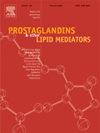Ceramide and DNA damage in liver fibrosis: Exploring the implications of eicosapentaenoic acid encapsulation in cellulose nanocrystals
IF 2.5
3区 生物学
Q3 BIOCHEMISTRY & MOLECULAR BIOLOGY
Prostaglandins & other lipid mediators
Pub Date : 2025-03-19
DOI:10.1016/j.prostaglandins.2025.106985
引用次数: 0
Abstract
Ceramide plays a crucial role in promoting liver fibrosis by inducing apoptosis and inflammation in hepatocytes. Oxidative stress accelerates fibrosis by elevating levels of urinary 8-hydroxy-2′-deoxyguanosine (8-OHdG), an indicator for the damage of DNA. We aimed to evaluate the efficacy of eicosapentaenoic acid encapsulated in cellulose nanocrystals (EPA-CNC) in inhibiting ceramide accumulation and reducing urinary 8-OHdG levels, thus providing protective effects against the progression of liver fibrosis.
In this study, twenty-four adult male Wistar albino rats were allocated into a negative control group, a group with liver fibrosis induced by diethylnitrosamine (DEN), and a group with DEN-induced liver fibrosis treated simultaneously with EPA-CNC. Key parameters assessed included liver paraoxonase-1 (PON-1), plasma interleukin-6 (IL-6), plasma ceramide, liver hydroxyproline (Hyp) content, and urinary 8-OHdG.
DEN-induced liver fibrosis led to a significant increase in inflammatory markers, including ceramide, IL-6, and notably urinary 8-OHdG. This was accompanied by a decrease in PON-1 activity and increased collagen deposition in liver tissues (Hyp content). Histopathological analysis revealed a substantial loss of liver architecture, with inflammation and fibrosis surrounding necrotic areas.
In contrast, treatment with encapsulated EPA-CNC resulted in a significant decrease in plasma ceramide, IL-6, liver Hyp content, and urinary 8-OHdG levels, along with an improvement in liver PON-1 activity. Histopathological findings showed nearly normal liver architecture.
In conclusion, increased levels of ceramide and urinary 8-OHdG could serve as indicators of ongoing hepatocellular damage due to their positive correlations with fibrotic markers. Encapsulated EPA-CNC may offer a promising approach for halting oxidative stress and inflammation in liver fibrosis.
肝纤维化中的神经酰胺和DNA损伤:探索纤维素纳米晶体中二十碳五烯酸包封的意义。
神经酰胺通过诱导肝细胞凋亡和炎症在促进肝纤维化中起重要作用。氧化应激通过提高尿8-羟基-2'-脱氧鸟苷(8-OHdG)水平加速纤维化,8-OHdG是DNA损伤的指标。我们旨在评估纤维素纳米晶体包封的二十碳五烯酸(EPA-CNC)在抑制神经酰胺积累和降低尿8-OHdG水平方面的功效,从而对肝纤维化的进展提供保护作用。本研究将24只成年雄性Wistar白化大鼠分为阴性对照组、二乙基亚硝胺(DEN)致肝纤维化组和EPA-CNC同时治疗DEN致肝纤维化组。评估的关键参数包括肝脏对氧磷酶-1 (PON-1)、白细胞介素-6 (IL-6)、神经酰胺、肝脏羟脯氨酸(Hyp)含量和尿液8-OHdG。den诱导的肝纤维化导致炎症标志物显著增加,包括神经酰胺、IL-6,尤其是尿8-OHdG。这伴随着PON-1活性的降低和肝组织胶原沉积的增加(Hyp含量)。组织病理学分析显示肝脏结构严重受损,坏死区域周围有炎症和纤维化。相比之下,包封EPA-CNC治疗导致血清神经酰胺、IL-6、肝脏Hyp含量和尿8-OHdG水平显著降低,同时肝脏PON-1活性改善。组织病理学结果显示肝脏结构基本正常。综上所述,神经酰胺和尿8-OHdG水平的升高可以作为肝细胞持续损伤的指标,因为它们与纤维化标志物呈正相关。包封的EPA-CNC可能为阻止肝纤维化中的氧化应激和炎症提供有前途的方法。
本文章由计算机程序翻译,如有差异,请以英文原文为准。
求助全文
约1分钟内获得全文
求助全文
来源期刊

Prostaglandins & other lipid mediators
生物-生化与分子生物学
CiteScore
5.80
自引率
3.40%
发文量
49
审稿时长
2 months
期刊介绍:
Prostaglandins & Other Lipid Mediators is the original and foremost journal dealing with prostaglandins and related lipid mediator substances. It includes basic and clinical studies related to the pharmacology, physiology, pathology and biochemistry of lipid mediators.
Prostaglandins & Other Lipid Mediators invites reports of original research, mini-reviews, reviews, and methods articles in the basic and clinical aspects of all areas of lipid mediator research: cell biology, developmental biology, genetics, molecular biology, chemistry, biochemistry, physiology, pharmacology, endocrinology, biology, the medical sciences, and epidemiology.
Prostaglandins & Other Lipid Mediators also accepts proposals for special issue topics. The Editors will make every effort to advise authors of the decision on the submitted manuscript within 3-4 weeks of receipt.
 求助内容:
求助内容: 应助结果提醒方式:
应助结果提醒方式:


